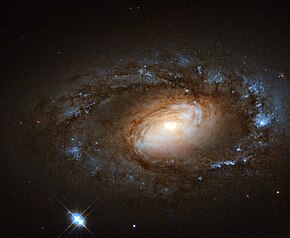| NGC 4102 | |
|---|---|
 NGC 4102 imaged by the Hubble Space Telescope NGC 4102 imaged by the Hubble Space Telescope | |
| Observation data (J2000 epoch) | |
| Constellation | Ursa Major |
| Right ascension | 12 06 23.115 |
| Declination | +52° 42′ 39.42″ |
| Redshift | 0.002792 |
| Heliocentric radial velocity | 837 km/s |
| Distance | 59.6 Mly (18.3 Mpc) |
| Group or cluster | Ursa Major group |
| Apparent magnitude (V) | 11.2 |
| Apparent magnitude (B) | 11.8 |
| Characteristics | |
| Type | SAB(s)b, SABab |
| Apparent size (V) | 2.9′ × 1.8′ |
| Notable features | LINER |
| Other designations | |
| IRAS 12038+5259, 2MASX J12062311+5242394, WISE J120623.07+524239.8, UGC 7096, LEDA 38392, MCG MCG+09-20-094, PGC 38392, SDSS J120623.00+524240.1 | |
NGC 4102 is an intermediate barred spiral galaxy located in the northern constellation of Ursa Major. It is visible in a small telescope and has an apparent visual magnitude of 11.2. The galaxy was discovered April 12, 1789 by William Herschel. J. L. E. Dreyer described it as "bright, pretty small, round, brighter middle and bright nucleus". This galaxy is located at a distance of 60 million light years and is receding with a heliocentric radial velocity of 837 km/s. It is a member of the Ursa Major group of galaxies.
The morphological class of NGC 4102 is SABab or SAB(s)b?, which is a spiral galaxy with a bar-like feature around the core (SAB), no inner ring structure (s), and moderately tightly-wound spiral arms ('ab' or 'b'). However, the bar in this galaxy is considered particularly small for galaxies of this class. The galactic plane is inclined at an angle of 56°±2° to the line of sight from the Earth. NGC 4102 has a region of intense star formation in the nuclear region, known as a starburst region. This volume is 1,000 ly (310 pc) in diameter containing some 3 billion solar masses. An outflow of hydrogen has been detected, extending outward to the northwest as far as 6.3 kpc (21 kly) from the nucleus.
The core of NHC 4102 is almost certainly an active galactic nucleus (AGN), which indicates it has a supermassive black hole (SMBH) that is generating energy by accreting material. It is an X-ray source with a spectrum similar to a Seyfert 2 galaxy. This type of AGN is known as a Type-2 LINER, or low-ionization nuclear emission-line region. This is due to a core that is obscured by intervening dusty materials and/or the SMBH is accreting material in an inefficient manner. The bolometric luminosity of the active nucleus is ~7×10 erg·s.
One supernova has been observed in NGC 4102: SN 1975E (type unknown, mag. 16.7) was discovered by Yvonne Dunlap and Justus R. Dunlap on 7 May 1975.
References
- ^ "This is no supermodel spiral". www.spacetelescope.org. ESA/Hubble. Retrieved 2 December 2014.
- ^ Skrutskie, Michael F.; et al. (1 February 2006). "The Two Micron All Sky Survey (2MASS)". The Astronomical Journal. 131 (2): 1163–1183. Bibcode:2006AJ....131.1163S. doi:10.1086/498708. ISSN 0004-6256. S2CID 18913331.
- ^ Ann, H. B.; et al. (2015). "A Catalog of Visually Classified Galaxies in the Local (z ~ 0.01) Universe". The Astrophysical Journal Supplement Series. 217 (2): 27. arXiv:1502.03545. Bibcode:2015ApJS..217...27A. doi:10.1088/0067-0049/217/2/27. S2CID 119253507.
- ^ Tully, R. Brent; et al. (2016). "Cosmicflows-3". The Astronomical Journal. 152 (2): 21. arXiv:1605.01765. Bibcode:2016AJ....152...50T. doi:10.3847/0004-6256/152/2/50. S2CID 250737862. 50.
- ^ Lianou, S.; et al. (November 2019). "Dust properties and star formation of approximately a thousand local galaxies". Astronomy & Astrophysics. 631: 19. arXiv:1906.02712. Bibcode:2019A&A...631A..38L. doi:10.1051/0004-6361/201834553. S2CID 174801441. A38.
- ^ Beck, Sara C.; et al. (October 2010). "NGC 4102: High-resolution Infrared Observations of a Nuclear Starburst Ring". The Astrophysical Journal. 722 (2): 1175–1179. arXiv:1008.1800. Bibcode:2010ApJ...722.1175B. doi:10.1088/0004-637X/722/2/1175. S2CID 118849324.
- ^ O'Meara, Steve (2007). Herschel 400 Observing Guide. Cambridge University Press. p. 98. ISBN 9780521858939.
- ^ "NGC 4102". SIMBAD. Centre de données astronomiques de Strasbourg. Retrieved 2021-12-22.
- ^ "NED results for object NGC 4102". NASA/IPAC Extragalactic Database. Retrieved 8 December 2014.
- ^ Erwin, Peter; Debattista, Victor P. (June 2013). "Peanuts at an angle: detecting and measuring the three-dimensional structure of bars in moderately inclined galaxies". Monthly Notices of the Royal Astronomical Society. 431 (4): 3060–3086. arXiv:1301.0638. Bibcode:2013MNRAS.431.3060E. doi:10.1093/mnras/stt385.
- ^ Seligman, Courtney. "NGC 4102 (= PGC 38392)". Celestial Atlas. Retrieved 2021-12-23.
- ^ Verheijen, Marc A. W. (December 2001). "The Ursa Major Cluster of Galaxies. V. H I Rotation Curve Shapes and the Tully-Fisher Relations". The Astrophysical Journal. 563 (2): 694–715. arXiv:astro-ph/0108225. Bibcode:2001ApJ...563..694V. doi:10.1086/323887. S2CID 18676545.
- ^ "Hubble Spies Charming Spiral Galaxy Bursting with Stars". SpaceDaily. 8 December 2014.
- ^ Trent Braun, Timothy; van Zee, Liese; Richards, Emily E.; McQuinn, Kristen B.; Skillman, Evan D.; Edges (January 2015). "Detection of an Extended Outflow in NGC 4102". AAS Meeting #225. 225. American Astronomical Society. Bibcode:2015AAS...22525027T. 250.27.
- ^ Mathur, Smita; et al. (October 2008). Finding Local Low-mass Supermassive Black Holes. Observational Evidence for Black Holes in the Universe: Proceedings of the 2nd Kolkata Conference on Observational Evidence for Black Holes in the Universe held in Kolkata India, 10-15 February 2008 and the Satellite Meeting on Black Holes, Neutron Stars, and Gamma-Ray Bursts held 16-17 February 2008. AIP Conference Proceedings. Vol. 1053. pp. 43–49. arXiv:0807.0422. Bibcode:2008AIPC.1053...43M. doi:10.1063/1.3009521.
- ^ González-Martín, O.; et al. (March 2011). "Suzaku observation of the LINER NGC 4102". Astronomy & Astrophysics. 527: 10. arXiv:1012.3080. Bibcode:2011A&A...527A.142G. doi:10.1051/0004-6361/201016097. S2CID 53470087. A142.
- Marsden, Brian G. (9 May 1975). "Circular No. 2776 - SUPERNOVA IN NGC 4102". Central Bureau for Astronomical Telegrams. Smithsonian Astrophysical Observatory, IAU. Retrieved 3 December 2024.
- "SN 1975E". Transient Name Server. IAU. Retrieved 3 December 2024.
External links
 Media related to NGC 4102 at Wikimedia Commons
Media related to NGC 4102 at Wikimedia Commons
| Astronomical catalogs | |
|---|---|
| NGC | |
| UGC | |